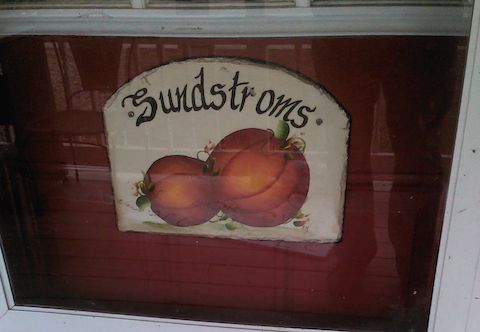
A sign on the door at 1884 South River Road in Walton, the former home of Debra and Randy Sundstrom. Photo by David J. Krajicek.
WALTON, N.Y.--When Randy Sundstrom disappeared three years ago, his wife had an explanation that prompted hugs of sympathy, not arched eyebrows of suspicion.
“He ran off with another woman,” Debra Sundstrom said. “Believe me, you didn’t know the real Randy. Good riddance.”
She repeated the story to friends, neighbors, coworkers and, eventually, even to the mother of her own new love interest. Sometimes she added more gasp-inducing details—that the new girlfriend was pregnant, for example, or that Randy beat her.
But Randy Sundstrom had not run off. He was dead -- at Debra’s hand, the authorities say. And for more than 1,000 days, his remains were hidden in plain sight, moldering inside a barrel 25 paces from the back door of the old farmhouse they renovated outside of Walton.
The murder came to light on February 19 -- curiously, the three-year anniversary of the date that Randy Sundstrom was last seen alive.
Law enforcers tracked Debra that day to a house on a dead-end clove on the other side of Walton where she was staying with her boyfriend, Dominick Bosco. When they knocked, the officers expected a routine arrest in connection with a petty theft.
Unwittingly, they stumbled into the conflagration of Debra Sundstrom’s life. There was now another body -- Bosco’s, in the basement. She saw that the jig was up.
Sundstrom closed the door and grabbed a deer rifle, and the simple warrant service was transformed into a messy investigation of two homicides, a suicide, a torched house and a dead dog.
“It seems like she was backed into a corner and could see no way out,” said Kathryn Seifert, a Maryland forensic psychologist who has written extensively about domestic violence. “She can’t think of another solution to this awful situation. So she snaps.”
Randy's friend: ‘I should have known’
Each year in America, roughly 750 marriages are terminated by murder, according to U.S. Justice Department statistics. Most are impulsive homicides triggered by an argument and influenced by drugs or alcohol.
More rare are cases that involve connivance, like that of Debra Sundstrom. It was exceptional for another reason: Among spousal murders, a male is the victim in just two of every 10 cases.
Few homicides can be predicted, but the Walton case has left friends of the Sundstroms wondering whether they missed tip-offs of trouble.
“What kills me the most,” said the Sundstroms’ friend Bill Bobier, “is that all this time we thought Randy was the bad guy. I don’t blame myself, but in a way I should have known that Randy, being one of my best friends, would have tried to get ahold of me over all that time.”
Most perplexed are the loved ones of Bosco, 51, a Long Island man whose body was found in the burned house, a weekend retreat owned by his family. Sundstrom apparently had killed Bosco a day or two before she shot herself.
No one knows why, though some speculate that Bosco had learned of Randy Sundstrom’s murder.
“We don’t know how this could have transpired,” said his brother, John Bosco Jr. “I wish we did, but I guess there’ll be no real closure on what this psycho did.”
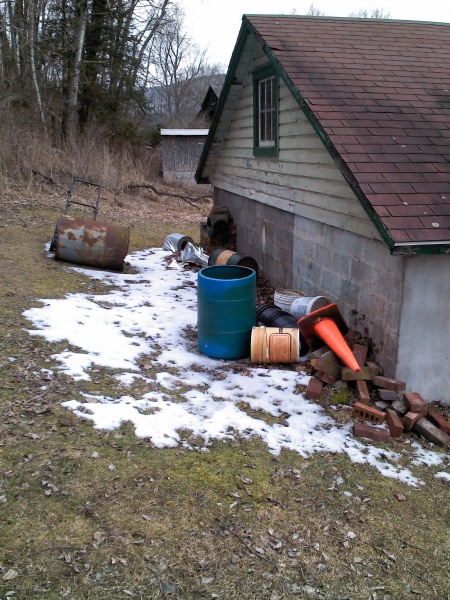
The site behind the Sundstroms' garage where Randy Sundstrom's body was found in a 55-gallon drum. Photo by David J. Krajicek.
A garden view to a kill
Debra Sundstrom, 48 when she died, could see the 55-gallon drum containing her husband’s remains from the side-yard vegetable gardens where she spent countless hours from early spring until late fall.
The barrel was 100 feet from the entrance to the Walton Pistol Club, in a barn owned by their neighbor, Al Budine.
“I must have mowed past that spot a hundred times,” Budine said, glancing across South River Road from his place and wagging his head.
Asked whether he knew the Sundstroms well, Budine replied, “I thought I did.”
He and the couple often chatted in their gardens. Randy and -- later -- Debra took their pet Australian shepherd for walks on the West Branch River flats, behind Budine’s house.
The Sundstroms, together for about 20 years, lived at 1884 South River Road, about two miles out in the country beyond the Delaware County Fairgrounds in Walton.
Debra was born in Sidney to William and Sandra Rieman on January 4, 1965. She and her three siblings grew up in Walton, and she graduated from high school there in 1984.
Randy was from Roscoe, one of three children of farmers Charles and Florence Sundstrom. He joined the Army in 1981, after high school, and served two years. He then operated a small-engine repair shop in Livingston Manor.
In 1989, Sundstrom fathered a child with his girlfriend. He split when she was a toddler.
Walton is just 30 miles from Livingston Manor. But for his child, it might as well have been on the other side of the world.
“I didn’t really know him,” said Melinda Sundstrom Lackey, now 23. “He was around until I was about 2. That’s when he met Debra and moved to Walton, and I didn’t see him again. He sent a few birthday cards, a necklace for Christmas one year, and a gift card when I graduated from high school. That was it.”
“From our belief, from everybody’s belief, it was Debra that kept him away from me,” said Lackey, known as Mindy. It was jealousy, she said.
Debra worked for years with a Delaware County social welfare agency. Later, after Randy disappeared, she began working as a grocery store cashier. Randy for many years commuted to Oneonta, where he worked in the warehouse for Drogan’s Home Furnishings. He worked his final years at Scott Machine Corp., an engraving firm in Walton.
In the late 1990s, the Sundstroms began growing giant pumpkins, and that became a social focal point of their life. Randy was the founding president of the New York State Giant Pumpkin Growers Association, and the couple appeared in the 2007 documentary film “Lords of the Gourd,” which followed pumpkin-growers preparing for the New York State Fair.
In 2004, Randy Sundstrom told the Daily Star’s Patsy Breakey that he found pumpkin-growing “habit-forming.” He said they set a goal in 1999 to break the state record for pumpkins. In 2008, they grew a pumpkin that weighed 1,459 pounds.
In their garden, they tended pumpkins, dozens of tomato plants and other standard vegetables as well as blueberries and grapes. They didn’t hang out at bars, and they didn’t go to church.
“They gardened,” said their friend Bill Bobier. “That was their religion.”
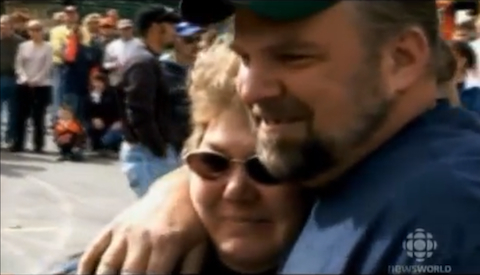
Debra and Randy Sundstrom in happier times. Screenshot from the 2007 documentary "Lords of the Gourd."
The Sundstroms: ‘Perfect for each other’
Bobier, who has a chimney-cleaning business in Windsor, N.Y., met the Sundstroms 15 years ago when Randy called with questions about pumpkins. He became Sundstrom’s pumpkin mentor and close friend. They visited each other’s homes for barbecues and spent many days together at pumpkin “weigh-offs.” The Sundstroms were like an aunt and uncle to his daughters, he said.
Each Christmas, Randy Sundstrom bought two collectable jackknives with pumpkin motifs. He gave one to Bobier and kept the twin for himself.
Bobier described Debra as “always happy and smiling” and Randy as “a really great guy.”
“We never saw issues, so to speak,” said Bobier. “They always just seemed perfect for each other. They were both into gardening, do-it-yourself, homebodies, homesteading types of things. It seemed like they really enjoying doing stuff together—growing together, canning together, cooking together.”
Bobier added, “Randy was the kind of guy who didn’t burden anybody with his problems...He was outgoing with his friends, but he kept any problems to himself.”
He said he was puzzled when Debra told him in 2010 that Randy had run off.
“She pretty much told us that Randy had met someone else, she got pregnant, and he had just taken off to start a new life,” Bobier said. “We thought maybe he was embarrassed or whatever. I always felt that when it was time for him to get in touch, he would.”
Bobier said he saw Debra a couple of times after her husband disappeared -- on a visit to Windsor and at a pumpkin weigh-off in Cooperstown. He tried to stay in contact but she distanced herself, changing phone numbers repeatedly.
Bobier said smiling Debra seemed more wrathful during their last conversations.
“She said, ‘You didn’t know the real Randy,’” Bobier said. “And she told my wife a story about him coming home late one night. She had the door locked, so he tried to break into the house. She said he hit her, and she hit back -- on the arm with a bat is what she said.”
At the time, that anecdote seemed like the bluster of a spouse left behind. But it grew more pertinent when Bobier picked up his morning paper on February 20 and read about the events in Walton.
“I said, ‘Holy cow,’” Bobier said.
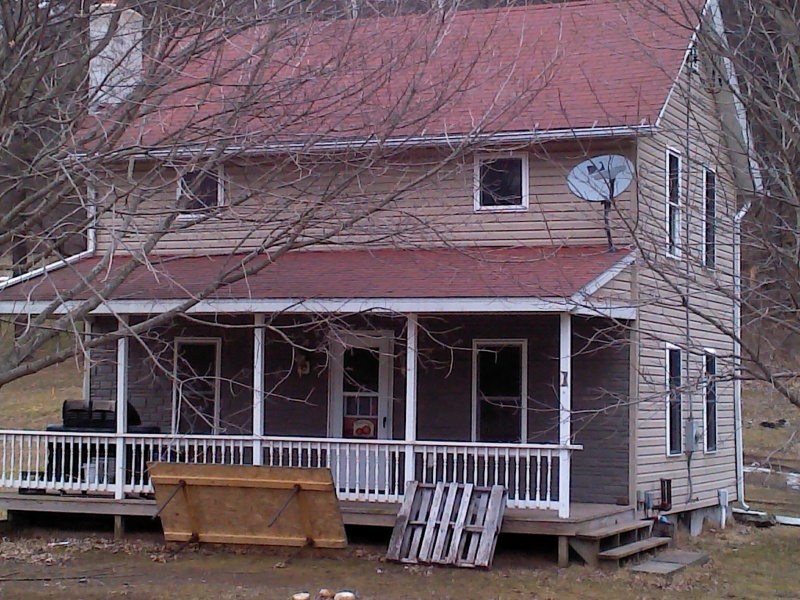
The Sundstroms' house from South River Road. Photo by David J. Krajicek.
Domestic violence motive? A neighbor bears witness
There was no girlfriend “that we know of,” said Lt. Erik Dauber of the New York State Police. He said investigators were unaware of the allegations of domestic violence between the Sundstroms, adding it was “not germane to the case.”
Debra Sundstrom’s parents, Bill and Sandra Rieman Sr. of Walton, the people who might know best about the nature of her marriage, politely declined to speak about their daughter.
But virtually everyone who knew the Sundstroms, including Bobier and Dominick Bosco’s kin, said they had heard about the alleged abuse.
John Bosco Jr. said Debra Sundstrom had told his mother, Marjorie, the familiar story.
“My mom had a conversation with her at some point,” Bosco Jr. said. “She said she had been in an abusive relationship -- that her ex-husband used to hit her. She said her ticket out was when he fell for someone else and took off.”
Of course, this was Debra’s account, and Randy Sundstrom was not available to give his version. But one witness, their neighbor Al Budine, said he saw first-hand evidence.
“I don’t believe in repeating rumors,” Budine said. “This is not rumor. I know it because I saw it.”
He said Debra Sundstrom twice ran across the road to his house, seeking refuge after she was “beat to hell” by her husband. He said he could not recall the dates but that one of the incidents was reported to local law enforcement.
Budine said he believes the domestic violence was ongoing and that it was the motive for Randy’s murder.
“There’s only so many times you can get hit by a shovel before you hit back,” Budine said. “She finally just snapped.”
Kathryn Seifert, the forensic psychologist, said Debra Sundstrom’s violent act fits a pattern that she has seen in abusive relationships. She called it a “rage reaction” not uncommon among women “who come to believe that they are unable to protect themselves.”
Budine said he had no doubt that Debra was strong enough to kill her stout husband, fold his body into the barrel and wheel it behind the garage.
“She could outwork any man,” he said.
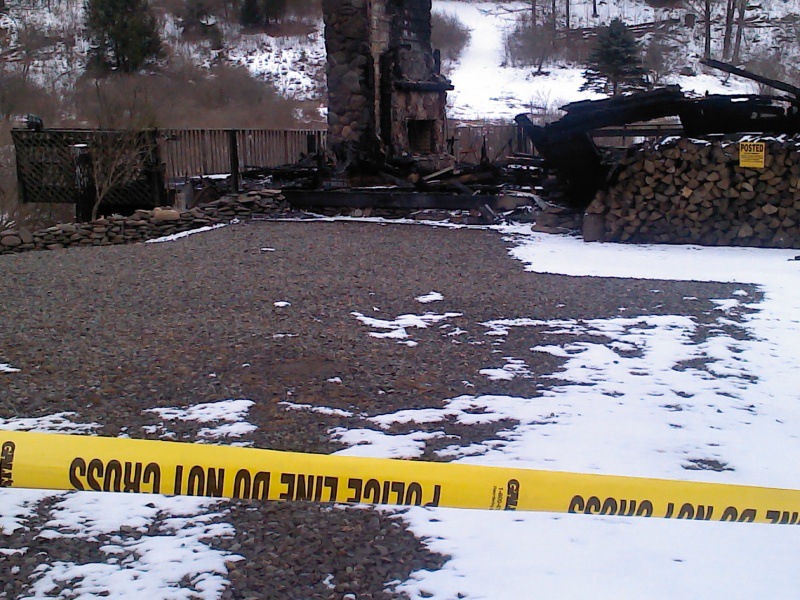
The scene of the crime: What remains of the house at 294 John Lockwood Road where Dominick Bosco and Debra Sundstrom died. Photo by David J. Krajicek.
Bosco: A forgotten victim
Sundstrom’s other victim, Dominick Bosco, has largely been a forgotten figure among the three deaths.
His family said he had begun dating Sundstrom last spring. He lived in East Moriches, Long Island, but Walton had been a second home for the Bosco family since the 1970s, when Dominick was a teenager. His father, John Bosco Sr., was a commercial flower-grower in Suffolk County. He was one of the first to buy property from farmer John Lockwood up a clove off East River Road a couple of miles from Walton village.
In 1977, the East Patchogue family built a weekend home near the top of dead-end John Lockwood Road, in the shadow of Bear Spring Mountain. Over the years, Bosco Sr. and his sons bought several more forested parcels adjacent to the house—some 200 acres in all.
Dominick Bosco, known as Nick to his family, graduated from Bellport High School in 1979. He retreated to the Walton woods as often as possible, his brother said.
“He loved the outdoors,” Bosco Jr. said. “We grew up in a farm-like atmosphere on Long Island. Our father raised cows. It was very rural back then.”
Dominick Bosco worked for a tree service on Long Island. When work slowed in the winter, he spent more time at the Walton house, whose ownership had been transferred to another brother, Patrick, a special agent with the U.S. Fish and Wildlife Service.
“Nick was always up there, helping Patrick out around the house,” Bosco Jr. said. It was on one such visit last spring that he began seeing Sundstrom.
Police Lt. Dauber said pathologists had so far been unable to determine how either Randy Sundstrom or Bosco died. Neither had obvious bullet wounds.
The mode of death puzzles Bosco’s family.
Nick Bosco was a rugged man, a husky 225 pounds. His body was found at the bottom of the basement stairs.
“He didn’t take this while looking straight at the person who killed him,” said Bosco Jr. “He would have been able to defend himself. That’s why we think she got him while he was sleeping or with poison, something very premeditated.”
Bosco was eulogized by his brother Patrick in a funeral Mass attended by hundreds of friends and relatives at St. Joseph the Worker Catholic Church in East Patchogue.
“What was he like? He was a hard worker, a very hard worker who was dedicated to whatever he did,” said John Bosco Jr. “He was an honest man, a standup guy. He never ran from the truth. He would tell what he thought…I can’t believe I’m not going to see him again.”
A stolen pocketbook
Perhaps Nick Bosco told Debra what he thought about the petty theft that ultimately revealed her secrets.
About two years ago, she took a job as a cashier at the Big M Supermarket in Walton. The owner, Jim Groff, told a reporter that Sundstrom worked hard and was a customer favorite. But she lost her job in February when she was accused of stealing a pocketbook that a customer had left at the store.
Charged with larceny, Sundstrom failed to appear in court, and a bench warrant was issued. Law enforcers learned that she spent time at the Bosco home. At about 2 p.m. on Feb. 19, Walton Police Chief Brian Laauser and Investigator Karl Vagts of the Delaware County Sheriff’s Office served the warrant at 294 John Lockwood.
Debra Sundstrom answered their knock, and the officers informed her she was being arrested. They agreed to give her a moment to change out of nightclothes.
“She shut the door,” Lt. Dauber later told reporters, “and it was within a minute they heard the two shots.”
Sundstrom acted fast after the door closed. She set the house ablaze. She then killed her Aussie shepherd, Shadow, with one shot from a .30-30 rifle. With a second, she killed herself.
The officers charged into the house and found her body upstairs. They escaped the fire and watched helplessly as the house burned, leaving only the wrap-around deck, a fireplace chimney and some cord wood near the front door. Firefighters saved a detached garage.
A few days later, as police were trying to figure out where Randy Sundstrom had disappeared to, a cadaver-sniffing dog solved the mystery when he barked and pawed at the barrel on South River Road. Dauber described Debra Sundstrom as the “only suspect” in her husband’s death.
Daughter Mindy Lackey: ‘I was freaking out’
Debra Sundstrom got away with murder for three years because no one reported Randy missing. His parents were dead, and he was not in contact with his two siblings, both of whom live out of state. His few close friends believed Debra’s story about his abandonment.
And in a sense, Debra benefited from his estrangement from the daughter she resented.
Mindy Lackey said it was surreal as she was gradually drawn into the crime drama involving a father she wouldn’t have recognized had she passed him on the street.
On Feb. 20, she returned a telephone message from a state trooper.
“It was just a crazy conversation,” Lackey said. “She said, ‘I just want to let you know that Debra committed suicide and caught the house on fire.’ I was like, okay—shocked and everything. She said they did not know where my father was, and they were trying to find him.”
For the next few days, she monitored the developing story on the Internet.
“I saw on the Walton Reporter website that they found a second body,” she said. “I was freaking out--what if it’s my father?”
A few days later, she returned another message from a trooper. Her father’s remains had been found—in the barrel, not in the burned house.
“They said, ‘I really hate to tell you this news over the phone, but your father is dead,’” Lackey said. “I still don’t know how to feel about it. This is the stuff I see on CSI, on television.”
The next day, she got one more phone call from police.
“They told me I was the legal next of kin and had to take care of his body,” she said. “It just, oh my god, threw me for a loop. I didn’t know what to do… I could have said, ‘He wasn’t there for the 23 years of my life so why should I be there for him now?’ But that’s just not who I am. I have a bigger heart than that.”
So she did the right thing. She organized a proper send-off for the stranger who was her father, including a military burial at Sullivan County Veterans Cemetery. She said she appreciated that a number of pumpkin-growers, including Bill Bobier, attended the funeral.
“They all told me some funny stories that lightened up the situation,” Lackey said. “They also said that he did mention me and that he really wished he was a part of my life. That put a big smile on my face. My father in their eyes was an awesome friend and a great man.”
David J. Krajicek is a journalist and true crime author based in the Catskills. He writes The Justice Story for the Sunday New York Daily News. He is also on Twitter at @djkrajicek.














